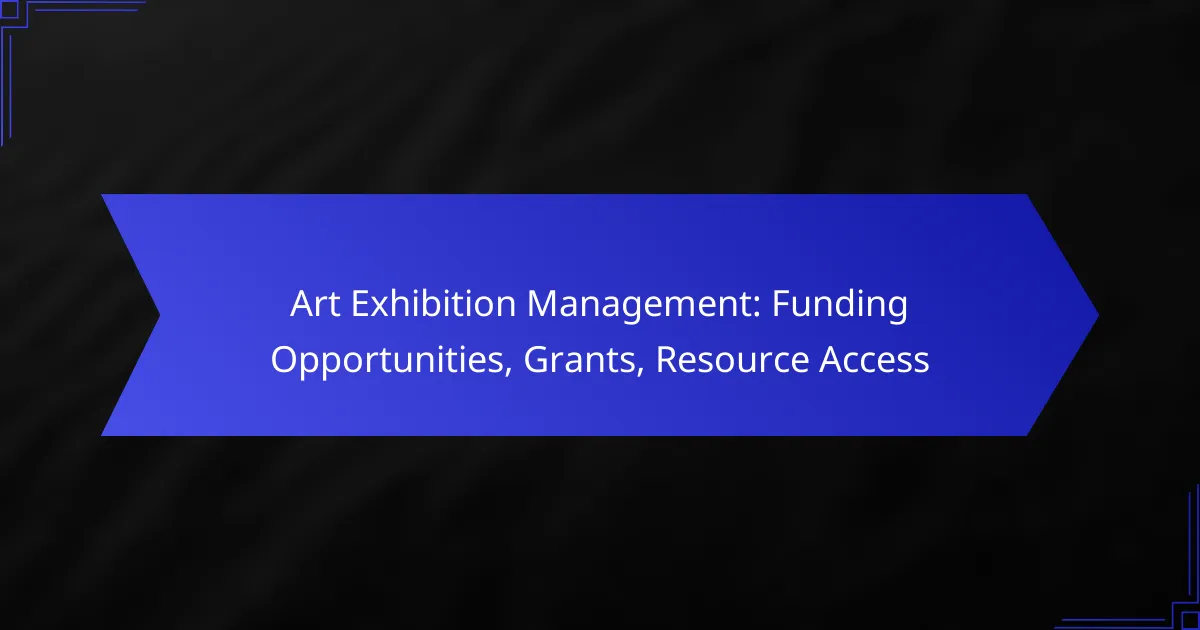Art exhibition management requires a thorough understanding of funding opportunities, including government grants, local arts councils, private foundations, and corporate sponsorships. Each funding source has distinct application processes and eligibility criteria, making it vital for organizers to explore various avenues to secure financial support. By crafting compelling proposals and leveraging networking and social media, artists and curators can significantly improve their chances of success in obtaining the necessary resources for their exhibitions.
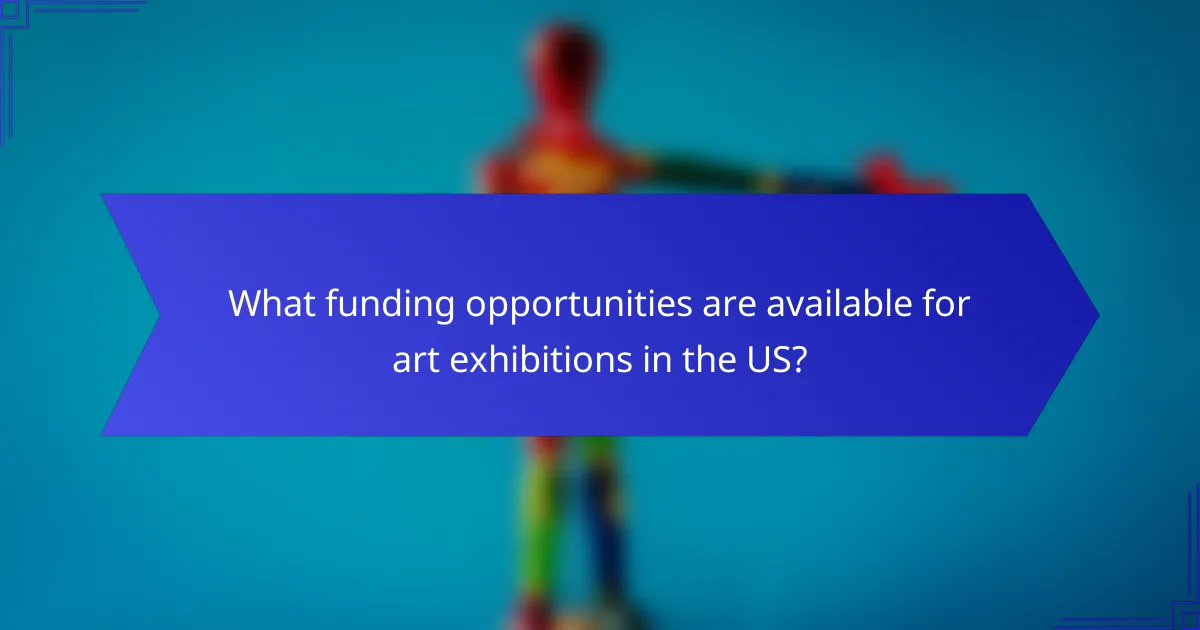
What funding opportunities are available for art exhibitions in the US?
Art exhibitions in the US can be funded through various sources, including government grants, local arts councils, private foundations, and corporate sponsorships. Each option has its own application process and eligibility criteria, making it essential for organizers to explore multiple avenues to secure funding.
National Endowment for the Arts grants
The National Endowment for the Arts (NEA) offers grants specifically designed to support art exhibitions across the country. These grants typically fund projects that promote artistic excellence and accessibility, with amounts varying widely based on the project scope and funding category.
To apply, organizations must submit a detailed proposal outlining their exhibition plans, budget, and expected impact. It’s crucial to adhere to NEA guidelines and deadlines, which are published annually.
Local arts council funding
Local arts councils provide funding opportunities tailored to community-based art initiatives, including exhibitions. These grants often prioritize projects that engage local audiences and foster community involvement.
Application processes can differ significantly by council, so it’s advisable to check specific requirements and deadlines. Many councils also offer workshops to help applicants navigate the funding process effectively.
Private foundation grants
Numerous private foundations support the arts through grants aimed at exhibitions, particularly those that align with their philanthropic missions. These foundations may focus on specific themes, such as cultural heritage or education, influencing their funding decisions.
When applying for these grants, it’s essential to tailor proposals to match the foundation’s interests and demonstrate how the exhibition will fulfill their objectives. Researching past funded projects can provide valuable insights into what foundations are looking for.
Corporate sponsorship programs
Corporate sponsorships can be a significant source of funding for art exhibitions, as businesses often seek to enhance their community engagement and brand visibility. Sponsorships may include financial support, in-kind donations, or promotional assistance.
To secure corporate sponsorship, organizations should create compelling proposals that outline the benefits for the sponsor, such as marketing exposure and networking opportunities. Building relationships with local businesses can also lead to fruitful partnerships that benefit both parties.
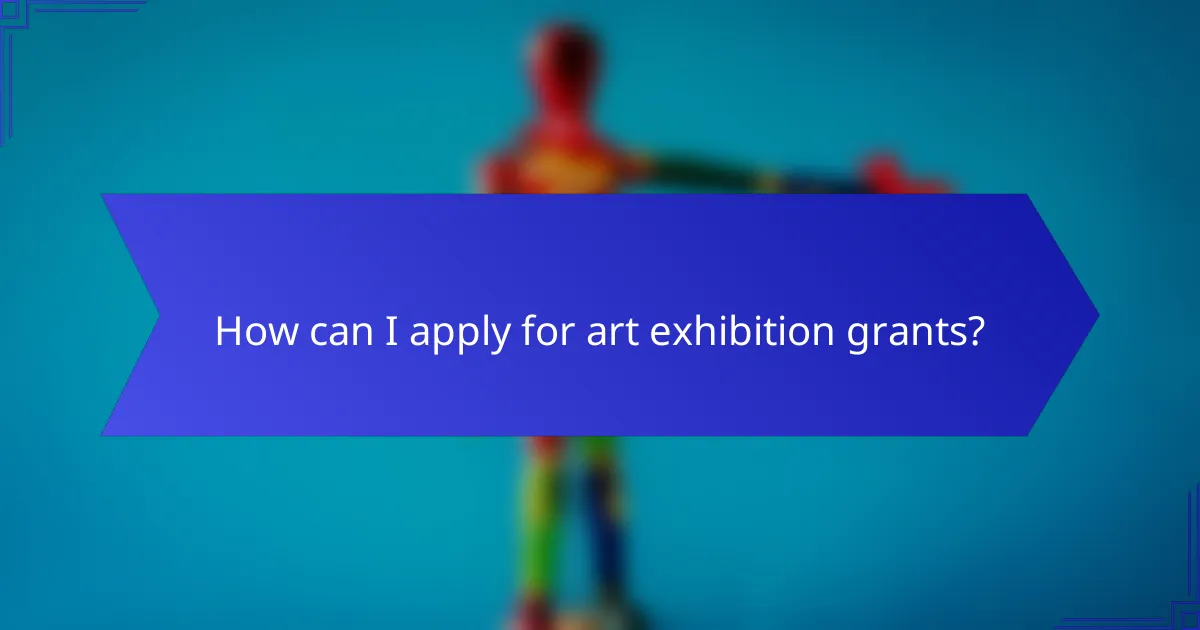
How can I apply for art exhibition grants?
To apply for art exhibition grants, start by identifying suitable funding sources that align with your project’s goals. Each grant has specific eligibility criteria and application procedures, so understanding these requirements is crucial for a successful submission.
Step-by-step application process
Begin by researching various grants available for art exhibitions. Look for local, national, and international opportunities that fit your artistic vision. Once you have identified potential grants, carefully read the guidelines to ensure your project meets their criteria.
Next, prepare your application materials, which typically include a project proposal, budget, and timeline. Submit your application before the deadline, as late submissions are often disqualified. Follow up with the grant organization if you do not receive confirmation of receipt.
Required documentation for grants
The documentation required for art exhibition grants usually includes a detailed project description, a budget outline, and a timeline. You may also need to provide a resume or CV highlighting your artistic background and previous exhibitions.
Some grants may require letters of support from collaborators or community members, as well as visual samples of your work. Ensure all documents are well-organized and clearly labeled to facilitate the review process.
Common application pitfalls
One common pitfall is failing to adhere to the grant’s specific guidelines, such as word limits or required formats. Always double-check that your application meets all criteria before submission.
Another issue is submitting incomplete applications. Ensure that all required documentation is included and that your project proposal is clear and compelling. Consider having a peer review your application to catch any errors or unclear sections before you submit.
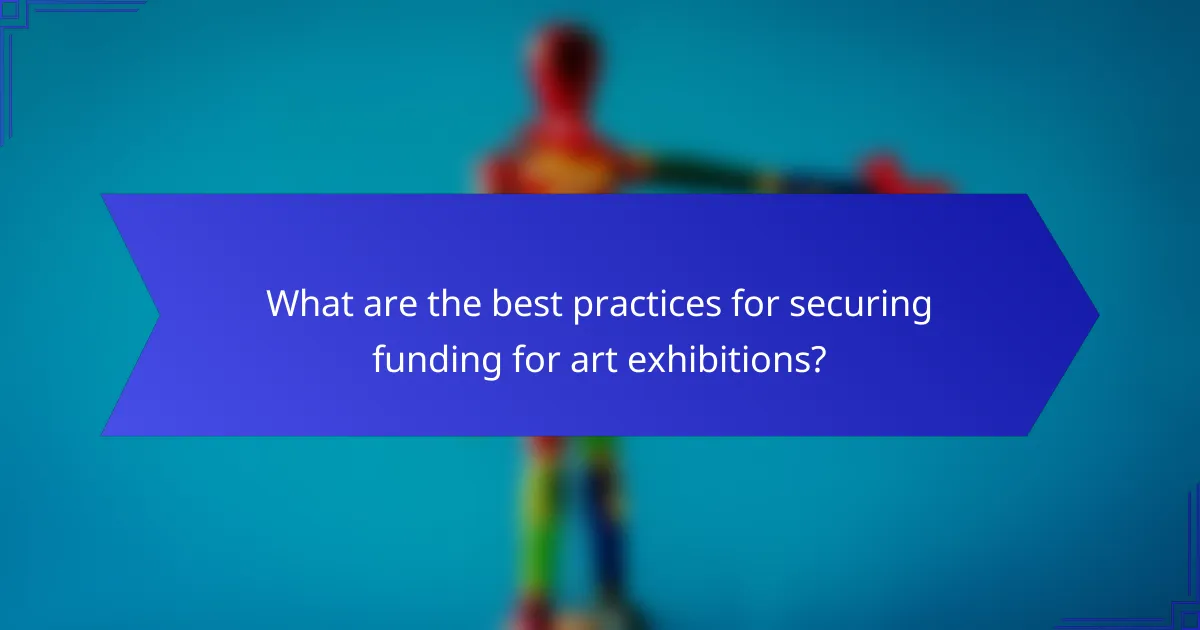
What are the best practices for securing funding for art exhibitions?
Securing funding for art exhibitions involves a strategic approach that combines well-crafted proposals, networking, and effective use of social media. By focusing on these best practices, artists and curators can enhance their chances of obtaining financial support.
Building a strong project proposal
A strong project proposal is essential for attracting funding. It should clearly outline the exhibition’s objectives, target audience, and budget. Include a detailed timeline and descriptions of the artworks and artists involved to provide potential funders with a comprehensive understanding of the project.
Consider tailoring your proposal to align with the interests of specific funders. Research their previous funding projects to identify common themes or priorities. This alignment can significantly increase your chances of securing support.
Networking with potential funders
Networking is a crucial element in securing funding for art exhibitions. Attend industry events, gallery openings, and art fairs to meet potential funders face-to-face. Building relationships can lead to more personalized support and increased trust in your project.
Utilize platforms like LinkedIn to connect with individuals in the arts funding community. Regularly engage with their content and share updates about your projects to keep your work on their radar.
Leveraging social media for visibility
Social media is a powerful tool for increasing visibility and attracting funding for art exhibitions. Use platforms like Instagram and Facebook to showcase your artwork, exhibition plans, and behind-the-scenes content. Engaging visuals can capture the attention of potential funders and art enthusiasts alike.
Consider creating a dedicated campaign around your exhibition, using specific hashtags and encouraging followers to share your posts. This can amplify your reach and create a community of supporters who may help in fundraising efforts.
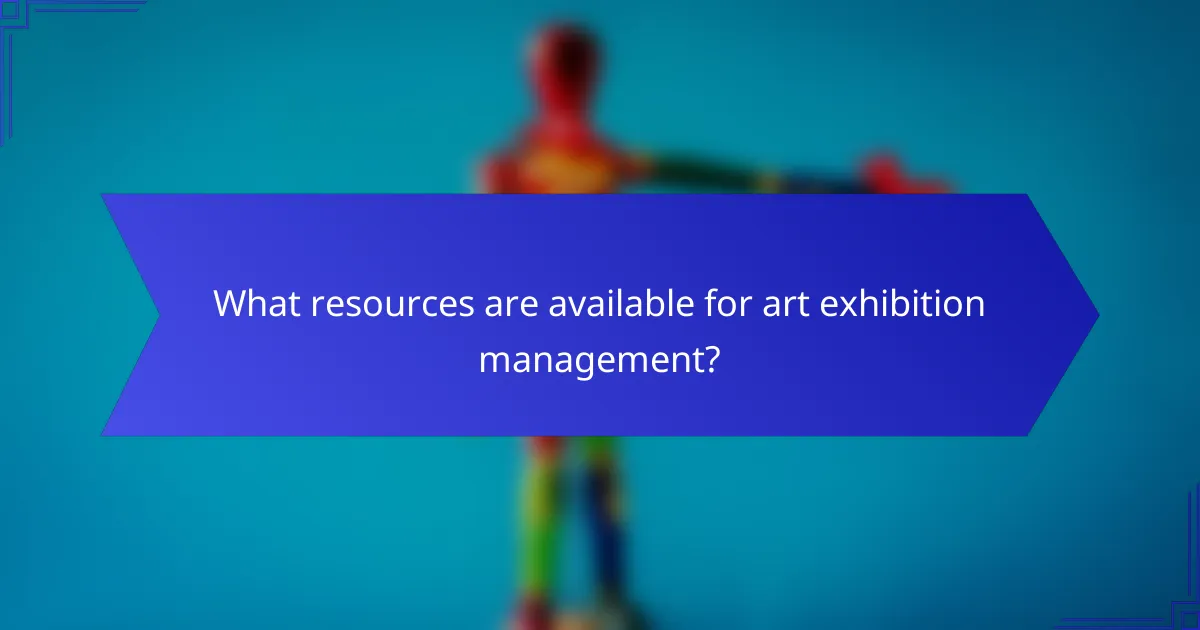
What resources are available for art exhibition management?
Art exhibition management relies on various resources, including funding opportunities, software tools, and educational programs. These resources help streamline the planning process, enhance operational efficiency, and secure financial support.
Online platforms for grant research
Online platforms for grant research provide vital information on funding opportunities specifically for art exhibitions. Websites like GrantWatch, Foundation Center, and Arts.gov allow users to search for grants based on specific criteria such as location, project type, and funding amount.
Utilizing these platforms can save time and increase the chances of securing funding. It is advisable to create alerts for new grant postings and regularly check for updates to stay informed about deadlines and eligibility requirements.
Art exhibition management software
Art exhibition management software simplifies the planning and execution of exhibitions by offering tools for scheduling, budgeting, and marketing. Programs like Artlogic, Exhibit-E, and Artwork Archive provide features tailored to the needs of curators and gallery managers.
When selecting software, consider factors such as user-friendliness, integration capabilities, and customer support. Many platforms offer free trials, allowing you to test their features before committing to a subscription.
Workshops and training programs
Workshops and training programs are essential for enhancing skills in art exhibition management. Organizations such as the American Alliance of Museums and local art councils often host events that cover topics like grant writing, marketing strategies, and project management.
Participating in these programs can provide valuable networking opportunities and insights from industry experts. Look for programs that offer hands-on experience and practical applications to maximize learning outcomes.
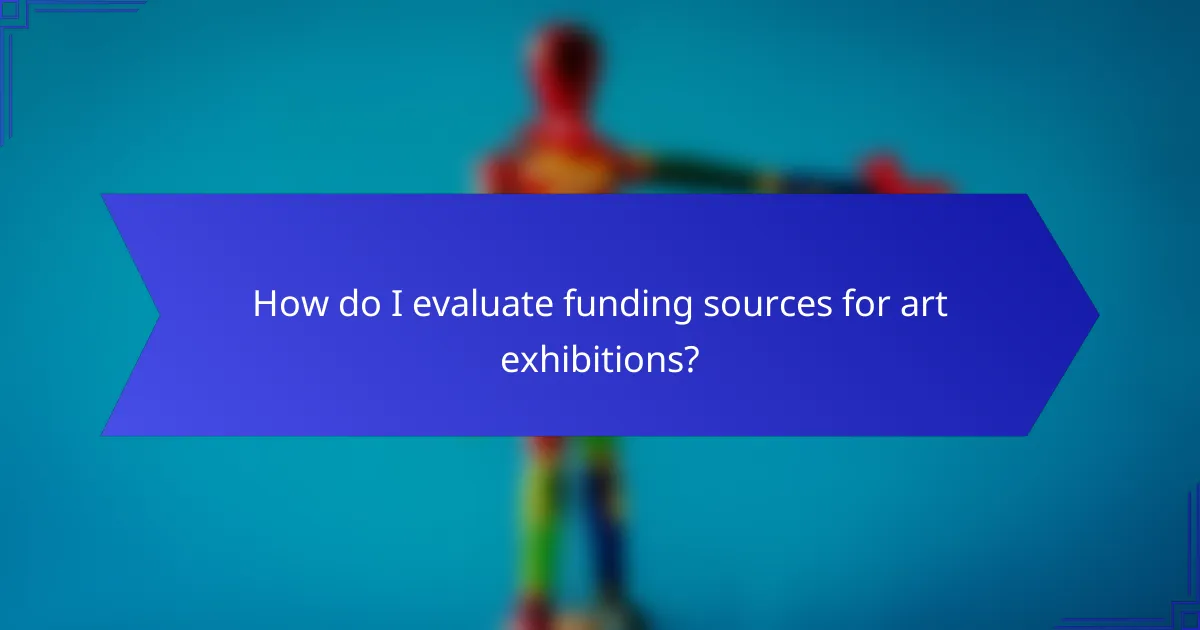
How do I evaluate funding sources for art exhibitions?
Evaluating funding sources for art exhibitions involves identifying potential funders and assessing their suitability based on specific criteria. This process ensures that the funding aligns with the exhibition’s goals and the values of the organization.
Criteria for selecting funding sources
When selecting funding sources, consider factors such as the funder’s mission, funding history, and application requirements. Look for funders that have previously supported similar projects or exhibitions, as this indicates a likelihood of interest in your proposal.
Additionally, evaluate the funding amount and terms. Some funders may offer grants in the low thousands to tens of thousands of dollars, while others may have specific restrictions on how the funds can be used. Understanding these details helps in making informed decisions.
Assessing funder alignment with project goals
To ensure alignment with project goals, review the funder’s priorities and values. This includes examining their stated objectives and any guidelines they provide for applicants. A strong match between your exhibition’s vision and the funder’s mission increases the chances of securing support.
Engage with potential funders through networking or informational meetings to gauge their interest and willingness to support your project. This direct interaction can provide insights into how well your goals resonate with their funding strategy.
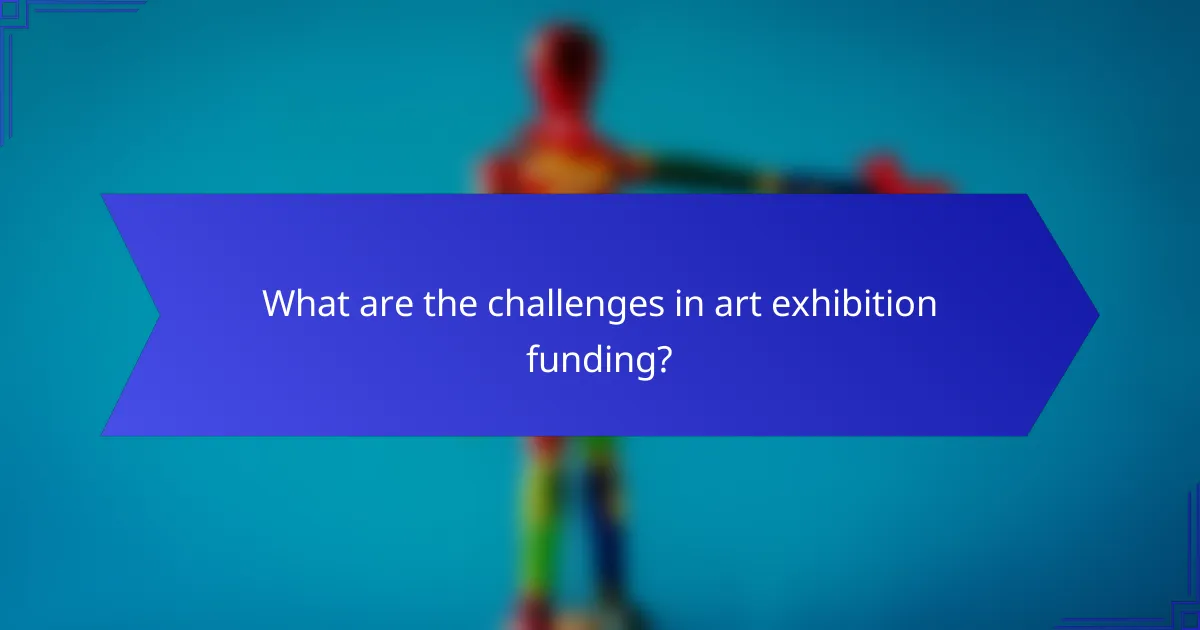
What are the challenges in art exhibition funding?
Art exhibition funding faces several challenges, primarily due to limited financial resources and evolving funding sources. Organizations and artists must navigate a competitive landscape while adapting to shifts in available grants and sponsorships.
Competition for limited resources
The competition for funding in the art sector is intense, with numerous exhibitions vying for the same pool of financial support. Many grants and sponsorships have strict eligibility criteria, making it essential for applicants to clearly demonstrate the impact and uniqueness of their projects.
To improve chances of securing funding, artists and curators should focus on building strong relationships with potential funders and showcasing previous successes. Networking within the art community can also lead to collaborative opportunities that enhance funding prospects.
Changing funding landscapes
Funding landscapes for art exhibitions are continually evolving, influenced by economic conditions and cultural trends. Traditional sources, such as government grants and private donations, may fluctuate, while new avenues like crowdfunding and corporate sponsorships are gaining traction.
Staying informed about these changes is crucial. Artists and organizations should regularly research funding opportunities and adapt their proposals to align with current priorities of funders, such as community engagement or sustainability. Utilizing online platforms for crowdfunding can also diversify funding sources and reach broader audiences.
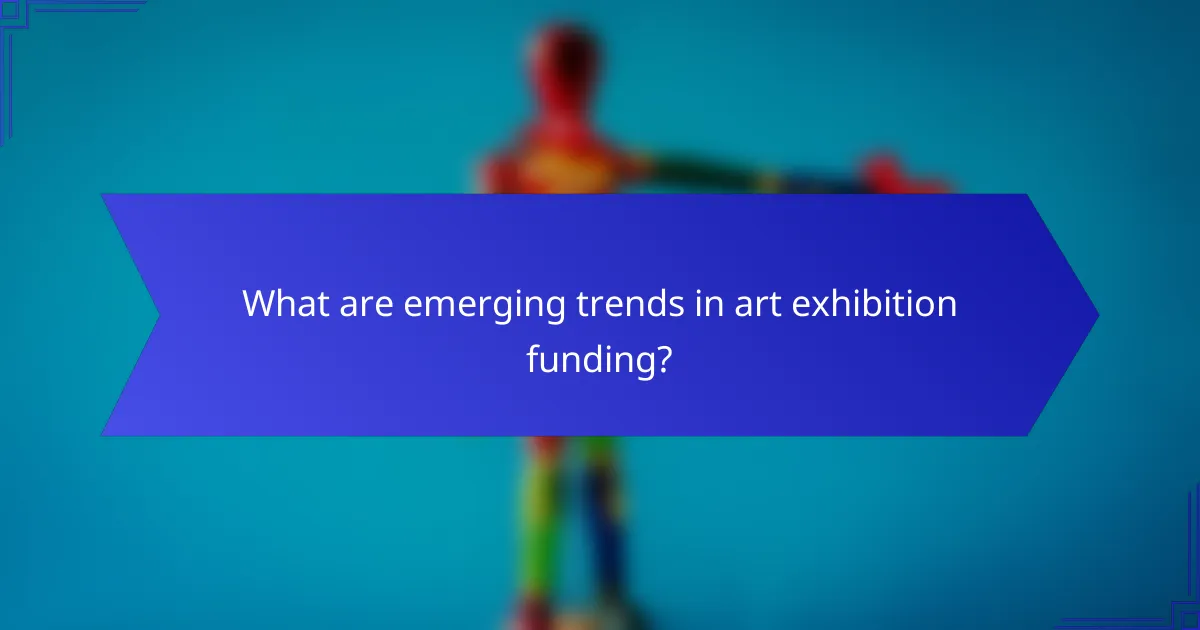
What are emerging trends in art exhibition funding?
Emerging trends in art exhibition funding reflect a shift towards more collaborative and sustainable practices. Funders are increasingly prioritizing projects that emphasize community engagement, diversity, and innovative use of technology.
Increased focus on sustainability
Sustainability is becoming a key criterion for funding art exhibitions. Many grant programs now require applicants to demonstrate how their projects will minimize environmental impact, such as using eco-friendly materials or reducing waste. This trend encourages artists and curators to think creatively about resource use.
For example, exhibitions that incorporate recycled materials or digital installations that reduce physical footprint may have a better chance of securing funding. Organizations like the National Endowment for the Arts in the U.S. are leading the way by promoting green practices in their grant guidelines.
Collaboration with community organizations
Collaborating with community organizations is gaining traction in art exhibition funding. Funders are looking for projects that engage local communities, fostering partnerships that enhance cultural relevance and accessibility. This approach not only broadens the audience but also enriches the exhibition’s content.
For instance, an exhibition that partners with local schools or cultural groups can receive additional support from both public and private funders. Such collaborations can also lead to shared resources, reducing costs and increasing impact.
Utilization of digital platforms
The rise of digital platforms is transforming how art exhibitions are funded and experienced. Online fundraising campaigns, virtual exhibitions, and social media outreach are becoming essential tools for securing financial support. These platforms allow artists to reach a wider audience and engage potential donors directly.
For example, crowdfunding platforms like Kickstarter or GoFundMe enable artists to present their projects to a global audience, often resulting in funding from diverse sources. Additionally, virtual exhibitions can attract sponsorships from tech companies interested in supporting innovative art initiatives.
Emphasis on diversity and inclusion
Diversity and inclusion are increasingly prioritized in funding decisions for art exhibitions. Funders are looking for projects that reflect a wide range of voices and perspectives, particularly those from underrepresented communities. This trend aims to create a more equitable art landscape.
Exhibitions that showcase diverse artists or address social justice themes may find it easier to secure funding. Organizations like the Ford Foundation are actively supporting initiatives that promote inclusivity, encouraging applicants to highlight their commitment to these values in their proposals.
